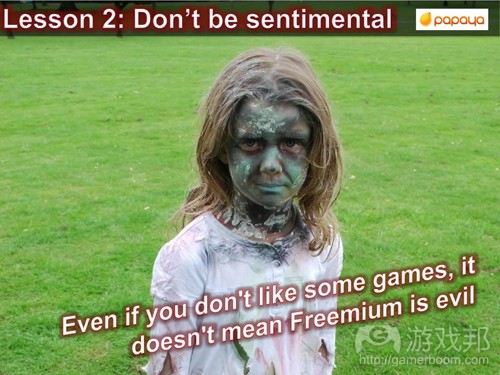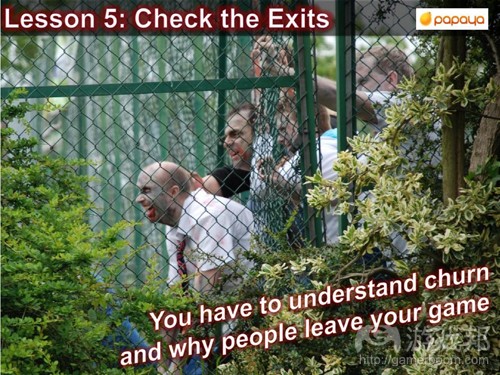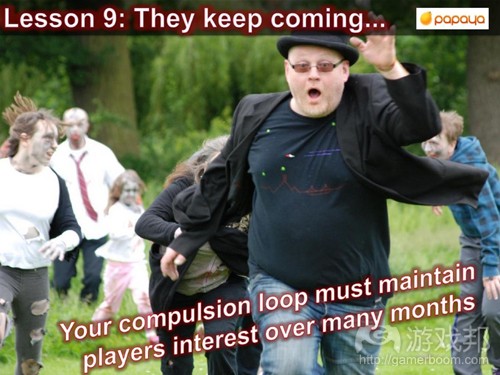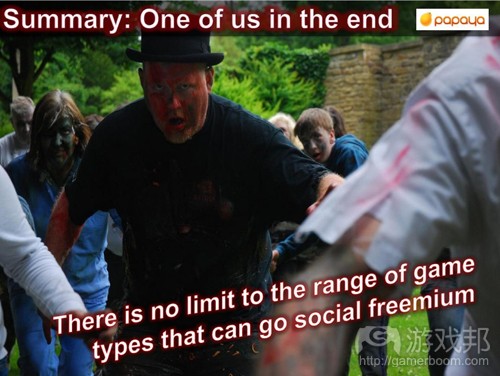“僵尸生存手册”—-Oscar Clark揭秘如何设计免费游戏
作者:Oscar Clark (手机社交游戏平台木瓜移动倡导者)
2011是游戏规则大变革的一年。由于颇具传染性的新一类游戏——免费游戏的主宰,收费游戏几乎从排行榜上消声匿迹。
本文以僵尸生存手册作比,旨在帮助游戏开发者理解免费游戏,指导其游戏工作室成功突围。
第1课:看清形势
好吧,当你的工作室正埋头于开发一款很好的游戏时,市场已经变了。
没有必要再争论免费和收费模式了,游戏市场已经发话,且排行榜也已经证实。当然,仍然会有某些收费游戏做得很好,但是在数量和收益上会越来越少。
现在是弱肉强食的时代,当开发和营销的成本不断增长,回避收益的游戏只能等待灭绝。
第2课:不要情绪化
即使你不喜欢某些游戏,也不意味着免费模式就不好。
许多游戏设计师不喜欢免费游戏,甚至怀疑游戏设计利用心理学技术是不道德的。这是一种剥削手段吗?
这样不好吗?
我不知道还有什么行业将利用心理学改进产品视作恶行。被捍卫道德的媒体卫士反复鞭笞之后,我们大概都患上了斯德哥尔摩综合症(游戏邦注:Stockholm syndrome,又称斯德哥尔摩症候群或者称为人质情结、人质综合症,是指罪犯的受害者对于罪犯产生感情,甚至反过来帮助犯罪者的一种情结,造成被害人对加害人产生好感、依赖心、甚至协助加害人)。也许这是像我这样的狂热鼓吹者的错误,用了“成瘾”这个词。
我们知道斯金纳箱:在老鼠和鸽子上做心理学实验,用于解释有规划的强化活动的作用方式。我们忘记了这些技术纯粹是让我们理解大脑如何解决问题,而解决问题正是游戏的乐趣来源。
斯金纳箱实验不能直接类比人类在游戏中的行为。要真正上瘾,玩家的行为目标(如食物、药物或金钱)必须能够触发内在的依赖性。在游戏中,我们是在解决问题的过程中收获乐趣,而不是问题这个对象本身。我们玩游戏为的是娱乐价值。
免费游戏设计师没有强迫玩家成瘾的魔法,并且玩家如果觉得自己被利用了自然会停止玩游戏。所以做好自己的游戏,让别人说去吧!
第3课:留意细节
与收费游戏不同,免费游戏要挣钱就必须拥有大量不断返回游戏的玩家。这意味着必须让玩家快速上手游戏,并且有足够的内容让玩家玩上几个月。
我们要关注小事物——简单、可重复、易上手的机制——但有足够的内涵支撑玩家一次又一次玩游戏。
记住,对玩家来说,游戏指南是最令人厌烦的东西之一,尽管收费游戏的玩家会找到乐趣,但免费游戏的玩家不会买帐。毕竟,他们没有花钱,他们没有必要看你的指南。
第4课:不可照搬照抄
众所周知,忘记历史间意味着重蹈覆辙。所以,为了改进免费游戏,我们必须学会吸取经验教训。
然而,学习不是抄袭。不只是因为有侵权的风险,还因为你并不能以此吸引被你抄袭的游戏的玩家。玩家往往厌烦衍生的游戏,如果他们知道自己玩的是抄袭作品就会觉得像是上当受骗一般。
这种被欺骗的感觉会使玩家失去对你的信任,因此不再推荐或购买你的产品。
当你正在开发一款运行于新设备的新版本游戏时,必须保证设备具有不同的“使用模式”,以体现其外形上的实用性。
例如,手机的外形小,方便用户外出携带,甚至一只手拿着,边走边用。虽然小尺寸意味着图象显示区域受限,但大大增加了即兴游戏的机会。
第5课:检查出口
你必须明白玩家为什么继续玩你的游戏,又为什么离开你的游戏。
这意味着我们不能单纯地看数据,而要具体问题具体分析,找出导致成功的有意义的因素。
游戏成功的关键是,产品都有生命周期,这是由各个玩家累积的游戏生命周期组成的。我们必须关注是,在不同的阶段,是什么原因让玩家离开游戏。
玩家是在学习阶段离开游戏的吗?还是经历第一次消费之历后?因为他们太快消耗完游戏?
第6课:“被咬会传染”
开发者要考虑如何利用社交游戏固有的病毒式传播力。除非你的玩家可以看到其他玩家——最好是玩家关注的人喜欢这款游戏,否则他们不会认为自己应该亲自玩玩你的游戏。
除非玩家可以向其他玩家炫耀自己的成功或进度,否则他们凭什么在你的游戏上花时间?除非他们可以炫耀自己的个人活动或技能,否则他们为什么要在你的游戏中花钱?
社交化的意义重大,如果我们忽略了这一点,后果严重。我们需要有意义的社交互动——不是强迫性或象征性的行为,使玩家对游戏产生更深层次的情感联系。
社交游戏向玩家发送非要求性的情感数据包,它具有针对玩家的关系本质的意义。它是有传染性的,因为它并不要求双方玩家在相同的游戏时间上同步,允许你自由选择下次登录时间。
不要把社交游戏与多人游戏混为一谈。即时多人游戏需要玩家在时间和空间上具有严格的同步性。
第7课:双发快射
如果你想要长期生存,那就不要毫无目的地开枪乱射。你得看看武器库里的武器。消耗品,就像经典的一次性“能量水晶”,可以让我们减少初次消费的成本,也让我们有理由一次又一次地购买。
但这种易消耗的东西存在问题,它们能减少玩家的短期风险,但也正是它们最终阻碍了玩家沉浸于游戏。
耐用品运应而生。这种道具不会消耗,因此让玩家觉得自己在游戏中的投资最大化了。例如,我们有一种“能量水晶之泉”每天都会提供20个能量水晶,怎么样?
为了最大化从虚拟商品中得到的价值,玩家必须天天登录游戏,天天使用这些水晶。
也许他们还会再花10块钱买能量水晶,为了多得20个水晶。
第8课:节约使用弹药
每一次消费都伴随着一阵懊悔的情绪,因为我们意识到商品(虚拟或真实的)永远不能达到我们之前的期望。
所以,我们必须保证玩家有个良好的初次消费体验,让他们有重复消费的理由。
初次消费必须简单、吸引人、物有所值。
第9课:持续性
游戏的强制性循环必须能让玩家的兴趣持续数月。
好游戏可以让玩家不断地玩上好几个月。但成功并非易事。
你必须保证玩家有足够的事情可做,足够的物品可买。你必须保证有能力扩大玩家规模,虽然在云计算时代,这已经容易多了,但仍然需要强大的的技术设计。
你必须把游戏当成一种定期服务来管理,比如每周一次升级。你越关注游戏玩家群体,玩家就会越支持你的游戏,为你的游戏提供建议。
第10课:切忌自我满足
即使你的游戏现在运作良好,自满自足也等于自杀。玩家渴望新内容,你必须不断地满足他们的胃口,才能让玩家继续玩你的游戏。
你可以利用游戏机制:制造约会、允许玩家在不在线的情况下发生有意义的社交互动,等等。但我们还必须确保自己有不间断的内容传递途径和产品拓展。
如果你的新内容可以定期地满意足玩家的期待,你就可以让原本可能流失的玩家停留在游戏世界中。
第11课:计算子弹
如果你想要生存,你必须理解数据的意义。
当玩家玩我们的游戏时,我们有更多的即时信息,即来自现实世界的活样本的数据。
然而,我们必须明白数据的局限性和意义。在训练数据分析师的过程中,我们要结合良好的设计直觉和成熟的设计师创造力。
第12课:一切都会过去
没有什么能天长地久,你的玩家基础也不例外。我们必须接受这个现实,并且努力维持。
有42%在“XX城市”这类游戏中消费的玩家,也为其他游戏花过钱。7%的玩家会在超过5款的游戏中花钱。我们必须理解这些玩家所处的阶段并做出相应的反应。
如果我们能够让玩家与新内容共同进退,我们便可以强化他们对我们的品牌和下一款游戏的喜爱。
第13课:8-12天后的转变
我们在免费模式中见到的最有趣的一类玩家是,鲸鱼型死忠玩家——即每月在游戏中消费满100美元的玩家。
在木瓜移动的平台上,我们看到这些玩家需要8-12天才开始在游戏中消费。这时候,他们也开始经常性地为能够炫耀(无论是升级的还是装扮)的商品花钱。
然而,大多数玩家是在“加速进程”的内容上花钱。这类虚拟商品可以让玩家享受到游戏中的大部分他们喜欢的东西,也就是最占他们游戏时间的东西。
总结:适者生存
社交免费模式并不仅限于特定游戏类型。
免费模式具有强大的破坏力,我们必须学会理解并运用这种力量。
免费模式可以提高游戏体验的品质,增加玩家数量。然而,免费模式也永远地改变了我们看待游戏设计的方式和“游戏即服务”的观点。
只有接受这一点的开发者才能够在这个市场竞争中幸存下来。(本文为游戏邦/gamerboom.com编译,拒绝任何不保留版权的转载,如需转载请联系:游戏邦)
PapayaMobile’s Oscar Clark provides a developer’s guide to the Zombie (freemium) Apocalypse
First of a two-part special on freemium, and the undead
by Oscar Clark
Oscar Clark is an evangelist for PapayaMobile, one of the leading mobile games social networks.
2011 was a year that changed all the rules. Premium games have been all but extinguished from the All Time Grossing charts and instead we have seen the, perhaps inevitable, domination of an infectious new breed of game: freemium.
This first part of a two part article is intended to help developers to avoid the Zombie Apocalypse and to help you prevent your game studio from becoming the Living Dead.
Lesson 1: Cardio
Okay, your studio may be making a great game, but the market has already changed.
There’s no longer any debate about freemium or premium. The market has spoken, and it takes no more than a look at the top grossing charts to prove that. There will, of course, still be those games that will still do better as premium, but they will be fewer in number and generally less profitable.
This is a Darwinian time, and by turning away revenue when the costs of creating and marketing quality games continue to rise, you are risking extinction.
Lesson 2: Don’t be sentimental
Even if you don’t like some games, it doesn’t mean Freemium is evil.
A lot of game designers don’t like the current batch of freemium games, and some even challenge the ethics of using psychological techniques in game design. Is this exploitation?
Is this evil?
I don’t know of any other industry that looks at the use of psychology to improve products as an act of devilry. Perhaps we have a form of Stockholm syndrome after being repeatedly (and wrongly) beaten up by the morality media police. Perhaps it’s the fault of evangelists, like me, using the language of addiction.
We talk about Skinner boxes: psychological tests on rats and pigeons to show how schedules of reinforcement work. We forget that these techniques simply allow us to understand how the brain solves puzzles, and solving puzzles is what makes games fun.
They are not a direct analogy for human behaviour in games. To become truly addictive, the object of your actions (i.e. the food/drug/money) needs to trigger an inherent dependency. In games, we derive pleasure from the action of solving puzzles, not the object of the puzzle itself. We play for entertainment value.
Freemium game designers don’t have magic powers and players stop playing when they feel exploited. Get over it and let’s just make better games!
Lesson 3: Enjoy the small things
Unlike premium, freemium games rely on large numbers of players coming back time after time in order to make money. This means players need to understand how to play immediately, and have enough content to keep them playing for months.
We need to focus on the small things – simple, repeatable mechanics that are easy to pick up and play – but have the scope to be played time and time again.
Bear in mind that tutorials are one of the biggest turn-offs for players, and although a premium player will push through to get to the fun, freemium players will churn. After all, they haven’t parted with money and they have no need to get past your tutorial.
Lesson 4: Check the back seats
As we all know; to ignore the past is to be condemned to repeat it. So, for freemium games to advance, we have to learn from what’s gone before.
However, it’s important to not just copy. Not just because of the risk of copyright infringement, but also because you won’t attract the same audience as the game you copy from. Players will often be bored by derivative titles, and can feel cheated if they think they’re playing a rip-off game.
This sense of being ripped-off will diminish the trust those players have in you, and therefore their willingness to recommend your game or purchase virtual content.
It is also important when you are creating new versions of games on new devices (e.g. moving from online to mobile) that each device will have a different ‘mode of use’ which drives the usefulness of its form factor.
For example, a phone’s small size makes it easy to use when out and about, even when the user is walking or holding it in one hand. This means that the area available for graphics is restricted, but there are plenty of opportunities for short, absorbing bursts of play.
Compare this with your PC, tablet, or console and you will quickly see how form factors have a profound effect on the way we play with each device.
Lesson 5: Check the Exits
You have to understand churn and why people leave your game.
You have to understand churn and why players leave your game just as well as you understand why they stay.
This means that we have to look beyond the simple snapshot view of data, and instead segment the information we get and figure out the meaningful success factors.
Key to this is the realisation that every product has a life cycle and this is made up of the accumulated life cycles of each player. We need to look at what happens to make players drop out of the game at different stages.
Do they leave during the learning stage? Do they leave after their first purchase? Do they exhaust the game too quickly?
Lesson 6: Bites are infectious
Every developer needs to consider how they can use the inherent virality of social games. Unless your players can see that other players care about this game – preferably players that they care about – why should they play it themselves?
Unless they can flaunt their success or progress to other players, why should they spend their time in your game? Unless they can show off their individual creativity or skill, why should they spend money on your game?
Socialisation is vital and we ignore it at our peril. We need meaningful social interactions – not forced or token actions – to build deeper emotional connection with the game.
Social games send a non-demanding packet of emotional data which has meaning specific to the nature of the relationship to the players. It’s infectious because it doesn’t assume both players have the same level of intensity for this game at the same time and this leaves a footprint in the sand for you each to discover the next time you log in.
Don’t confuse social games with multiplayer games. Real-time multiplayer requires an intense commitment to play together right here, right now.
Lesson 7: Double tap
If you want to survive in the long term, it’s no good shooting off virtual goods randomly. You need to look at the weapons in your armoury. Consumable goods, like the classic one-use ‘energy crystal’ allow us to reduce the cost of the initial purchase and give reasons to buy time and again.
But there’s a problem with consumables. The very things that make them work to reduce the short term risk for a player are the reasons they eventually become barriers to engagement.
Players have to continue to buy them to get through the game, and there is never anything to show for those purchases except in-game progress.
This is where durable goods come in. These are items that don’t run out and help players feel they are maximising their investment in the game. For example, what if we have a ‘Well of Energy Crystals’ that gives you 20 energy crystals each day?
To maximise the value a player gets from this virtual good they have to come back into the game every day and use all those crystals in the game.
And perhaps they’ll spend another 10c on an energy crystal to do just one more thing.
Lesson 8: Use ammo sparingly
Every purchase we make is followed by a sense of remorse, where we realise the reality of the good (virtual or otherwise) can never quite match the expectations we had before.
Therefore we can’t afford for players to start spending before their commitment is strong enough to survive this shock. We need to make sure players to have a great first purchase experience and give them positive reasons repeat that purchase time and again.
Their first purchase has to be easy, compelling, and extremely rewarding.
Lesson 9: They keep coming
Your compulsion loop must maintain players interest over many months.
If you get the game right, your players will keep coming back and want to be able to continue to play over many months. Success is not a trivial problem.
You need to ensure that players have enough to do and enough content to purchase. You need the ability to ensure that you can scale, and while that’s a lot easier to do now in the age of cloud computing, it still requires competent technical design.
You have to manage the game as a service with regular – probably weekly – content updates. The more you engage the community for your game, the more they’ll support and recommend your game.
Lesson 10: Complacency kills
Even if your game is doing well, complacency is suicide. Players crave new content and you need to constantly give them reasons to return to the game.
We can provide some of this through the mechanics of the game: creating appointments, allowing meaningful social interaction to happen when you are not online, etc. But we also need to make sure we have an ongoing pipeline of content and product extensions.
If you can schedule people’s expectation of when new content will arrive, this can provide a call to action for players to return who might otherwise churn.
Lesson 11: Count your bullets
If you want to survive this apocalypse you will have to understand your data.
We now have so much more information about what’s happening when people play our games, and it’s data from live subjects in the real-world.
However, we have to understand the limits of that data and what it can mean. We need the good design instincts and creativity of experienced designers working alongside trained data analysts.
Lesson 12: All this shall pass
Nothing lasts forever, and your playerbase is no exception. We have to accept this and work with it.
42 percent of players who spend money in games like X City spend money in more than one game. 7 percent spend money in more than five games. We have to understand what stage the player is at and respond accordingly.
If we can take them with us to new content, we can reinforce their appreciation of our brand in our next game
Lesson 13: 8-12 days to turn
One of the most interesting behaviours we have seen with freemium is the spending habits of the ‘Whale’ or ‘TrueFan’ users – the players that spend more than $100 per month.
On Papaya’s platform, we see these users take between 8-12 days before they start spending any money. They also start spend money often on goods which allow them to show off – either in terms of progression in the game or customisation.
However, the majority of their spending goes on ‘accelerators’. These are virtual goods that allow them to get the most out of playing a game they enjoy, and in which they invest considerable time.
Why shouldn’t they also spend money for that enjoyable content?
Summary: One of us in the end
There is no limit to the range of game types that can go social freemium.
The freemium model has a disruptive power which we have to learn to understand and respond to.
It will be an amazing force for quality of experience and increased accessibility to game play experiences. However, it will also change forever the way we look at game design and the way we look as games as services.
Those people who survive will be the ones who embrace this. You’ll be one of us in the end.(source:pocketgamer part 1,part 2)
下一篇:举例阐述平台游戏跳跃机制设计原理












































